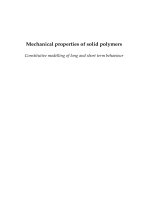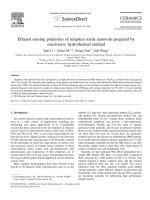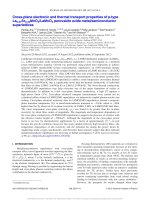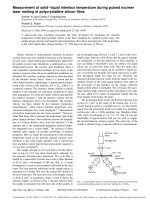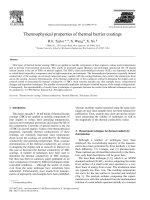Physico-mechanical properties of solid cement bricks containing recycled aggregates
Bạn đang xem bản rút gọn của tài liệu. Xem và tải ngay bản đầy đủ của tài liệu tại đây (920.75 KB, 8 trang )
Journal of Advanced Research (2012) 3, 253–260
Cairo University
Journal of Advanced Research
ORIGINAL ARTICLE
Physico-mechanical properties of solid cement
bricks containing recycled aggregates
Dina M. Sadek
*
Building Materials Research and Quality Control Institute, Housing and Building National Research Center, Egypt
Received 24 May 2011; revised 25 July 2011; accepted 1 August 2011
Available online 10 September 2011
KEYWORDS
Recycling;
Crushed clay brick;
Aggregates;
Solid cement bricks;
Compressive strength
Abstract Recycling and reuse of solid wastes as alternative building materials present interesting
possibilities for economy on waste disposal sites and conservation of natural resources. This paper
investigates the physical and mechanical properties of solid cement bricks manufactured with
crushed clay bricks as recycled aggregates. Four series of mixtures with cement content 100, 150,
200 and 300 kg/m3 were prepared. In each series, either natural fine aggregate, coarse aggregate
or both were replaced with crushed brick aggregates (CBA) at 0%, 50% and 100% by volume.
Compressive strength, unit weight and water absorption were determined and compared with the
relevant national and international standards for load bearing and non-load bearing units, respectively. The experimental results showed that as the replacement level of natural aggregates
increased, the unit weight and compressive strength of solid cement bricks decreased and the water
absorption increased regardless of cement content. Furthermore, it is possible to manufacture
different grades of solid cement bricks with CBA to be used as load bearing and non-load bearing
units depending on the size of the crushed bricks and the replacement percentage of natural aggregates.
ª 2011 Cairo University. Production and hosting by Elsevier B.V. All rights reserved.
Introduction
* Tel.: +20 2 33356722; fax: +20 2 33351564.
E-mail address:
2090-1232 ª 2011 Cairo University. Production and hosting by
Elsevier B.V. All rights reserved.
Peer review under responsibility of Cairo University.
doi:10.1016/j.jare.2011.08.001
Production and hosting by Elsevier
The sustainable construction concept was introduced due to
the growing concern about the future of our planet because
construction industry is a huge consumer of natural resources
and, simultaneously, a waste producer. Cement bricks industry is considered one of the biggest natural resource consumers. However, it may be used as a potential place for
recycling wastes, because of its composite nature (i.e., cement,
water and aggregates). Aggregates in solid cement bricks
comprise about 60–75% of the total volume, so any reduction in natural aggregates’ consumption will have significant
impacts. Recycling of wastes as natural aggregates is not only
economically viable but also it is considered as an
254
environmental friendly approach. Clay bricks are largely used
in Egypt. The quantity of masonry demolition waste is estimated to be around 2–3 and 1.5 times higher in buildings
with load bearing masonry and reinforced concrete framed
masonry infill as structural systems, respectively. Accordingly, a significant portion of demolition wastes is clay bricks.
In addition, brick manufacturing industry produces large
quantities of rejected fired bricks due to being off-standard
(i.e., broken, distorted, under burned, or over burned). The
off-standard bricks are sold for landscaping purposes, if economically feasible, but usually dumped into sites around the
brick factories causing environmental problems [1–3]. Thus,
the recycling of crushed bricks as alternative aggregates has
a particular interest as it can considerably reduce the problem
of waste storage and on the other hand can help in the preservation of natural aggregates [4].
A number of studies were conducted to evaluate the potential of using crushed bricks as aggregates. Hansen [5] and Padmini et al. [6] reported that for a given strength, the modulus of
elasticity of crushed brick concrete is between half and twothirds that of normal concrete and the water absorption and
sorptivity increased for concrete containing crushed brick
aggregates. Furthermore, concrete containing coarse crushed
bricks had a relatively lower strength at early ages than normal
aggregate concrete. This is due to the higher water absorption
of crushed brick aggregates compared to natural aggregates
[7].
Cachim [1] reported that crushed bricks could be used as a
partial replacement of natural coarse aggregate without reduction in concrete properties for 15% replacement and with
reductions up to 20% for 30% replacement. Khaloo [8] found
a decrease by 7% in concrete compressive strength by using
crushed clinker bricks as coarse aggregate compared to natural
aggregate concrete. Akhtaruzzaman and Hasnat [9] found that
although the tensile strength of concrete containing coarse
crushed brick was higher than that of normal concrete by
about 11%, the modulus of elasticity was 30% less than that
of normal concrete. Moreover, Kibriya and Speare [10] reported that concrete containing coarse crushed brick had comparable compressive, tensile and flexural strengths to those of
normal concrete but the modulus of elasticity was drastically
reduced. The use of brick aggregate significantly increased
the shrinkage, the initial surface absorption, chloride diffusion
and the creep of concrete was increased as well.
Poon and Chan [11] found that the incorporation of 20%
fine crushed brick aggregate decreased the compressive
strength and the modulus of elasticity of the concrete by
18% and 13%, respectively. Khatib [12] reported that concrete
incorporating up to 50% fine crushed bricks exhibited similar
long-term strength to that of the control concrete. At 100%
replacement of fine aggregate with crushed bricks, the reduction in strength was 10%. However, an increase in the expansion was recorded when the specimens were stored in water.
Debieb and Kenai [4] found that the compressive strength decreased by 35, 30 and 40%, respectively, when coarse, fine or
both fine and coarse aggregates were fully substituted by
crushed bricks. A reduction of the modulus of elasticity was
30%, 40% and 50% and that of the flexural strength was
33%, 36% and 46%, respectively. Water absorption, permeability and shrinkage of crushed brick aggregate concrete were
significantly greater than those of the natural aggregate concrete. They recommended that the use of crushed bricks
D.M. Sadek
aggregates should be limited to low performance concrete such
as pavement blocks and if crushed bricks are used in concrete
the substitution percentage should be limited to 25% and 50%
for the coarse and fine aggregates, respectively.
Bektas et al. [2] found that using up to 20% fine crushed
bricks had no negative effect on the mortar compressive
strength and very limited effect on the mortar shrinkage. On
the other hand, Corinaldesi and Moriconi [13] reported that
the compressive and flexural strengths of the mortars prepared
by fine crushed bricks are significantly lower than the control
mortar. Salih and AL-Azaawee [14] found that the compressive and splitting tensile strengths of mortar decreased and
the drying shrinkage increased by using 100% fine brick aggregates. The incorporation of crushed clay brick as aggregate
reduced the compressive and tensile strengths of the paving
blocks and significantly increased the water absorption. A
reduction in compressive strength up to 37% and 61% was recorded for the incorporation 25% and 75% replacement level
of recycled concrete aggregate by crushed clay brick [15]. Poon
and Chan [16] found that a blend of recycled concrete aggregate and crushed clay brick increased the optimum moisture
content and decreased the maximum dry density and CBR
values when used as a subbase material.
It is obvious that most of the researches focused on the
recycling of crushed bricks as either coarse or fine aggregate
individually in concrete, although it has a significant effect
on the strength especially at higher replacement percentages
of aggregates. Thus, its recycling is still limited especially in
developing countries. However, the shortcomings of using
crushed bricks can be avoided by the production of nonstructural concrete products such as cement brick. This paper
investigates the potential of using crushed clay bricks as alternative aggregates in the production of innovative solid cement
bricks to achieve the maximum recycling rates of that waste in
an efficient and economic manner and to conserve the natural
aggregates to be used in the important industries such as concrete industry. Compressive strength, unit weight and water
absorption of solid cement bricks containing crushed brick
aggregates were determined and compared with the limits of
the national and international standards for load bearing
and non-load bearing units.
Methodology
Materials
The used cement was CEM I 42.5 N complying with the Egyptian Standard Specifications (ES) 2421/2005 [17]. Sand and
dolomite were used as fine aggregate (FA) and coarse aggregate (CA), respectively. Coarse aggregate had a nominal maximum size of 14 mm. The recycled aggregates were crushed
clay bricks (referred in this paper as crushed brick aggregates
(CBA)), obtained as industrial waste from local factories in
Cairo, which were used as alternative coarse and fine aggregates. The coarse CBA were those passed from sieve No. 14
(14 mm) and retained on sieve No. 4 (4.76 mm), whereas fine
CBA were those passed from sieve No. 4 (4.76 mm). For practical reasons, no alteration was carried out on the grading of
the coarse or fine CBA. The aggregates properties are shown
in Table 1. The results showed that CBA had lower specific
gravity than natural aggregates; water absorption of CBA
Physico-mechanical properties of bricks containing recycled aggregates
Table 1
Physical properties of aggregates.
Property
Coarse aggregate
Specific gravity (SSD)
Unit weight (t/m3)
Absorption (%)
Moisture content (%)
Clay and fine materials (%)
Impact index (%)
a
b
255
Fine aggregate
Crushed stone
Crushed brick
Sand
Crushed brick
Limits
2.65
1.54
0.83
0.41
1.21
13.21
1.91
1.00
12.35
0.96
1.94
29.45
2.5
1.74
–
0.63
1.8
–
2.08
1.27
–
1.06
6.60
–
–
–
62.5a
–
64b
645b
According to the Egyptian code of practice issued 2007 [19].
According to ES 1109/2002 [18].
was several times higher than that of natural aggregates due to
the porosity characteristics of the clay brick which may be
40%.
Methods
Mixture proportions
From economic point of view, concrete, paving blocks, solid
cement brick, etc. are designed to achieve the target compressive strength with minimum cement content. So, the main
objective of the experimental program is to produce solid cement bricks satisfying the requirements of the national and
international standards (i.e., ES and ASTM) either for load
bearing units or non-load bearing units using crushed clay
Table 2
Mix
brick aggregates with minimum cement content as possible.
Four series of mixtures with cement content 100, 150, 200
and 300 kg/m3 were prepared. Either natural fine aggregate,
coarse aggregate or both were replaced with CBA. The substitution ratios of natural aggregates with CBA were 0%, 50%
and 100% by volume.
For each series, seven different mixtures were manufactured
to examine the influence of incorporating coarse and fine CBA
in solid cement bricks. Each mixture was identified with the
designation ‘‘MA-B’’, where ‘‘A’’ indicates the mixture No.
and ‘‘B’’ indicates cement content in the mixture. The control
mixture (M1) was manufactured with natural aggregates. In
mixtures M2 and M3, 50% and 100% of natural coarse aggregate was replaced with coarse CBA, respectively, while in
Mix proportions for solid cement bricks (kg/m3).
Cement
Fine aggregates
Coarse aggregates
Water
Sand
Crushed brick
Crushed stone
Crushed brick
M1-100
M2-100
M3-100
M4-100
M5-100
M6-100
M7-100
100
816
816
816
408
–
408
–
–
–
–
340
679
340
679
1224
612
–
1224
1224
612
–
–
441
882
–
–
441
882
170
193
215
199
227
221
263
M1-150
M2-150
M3-150
M4-150
M5-150
M6-150
M7-150
150
800
800
800
400
–
400
–
–
–
–
333
666
333
666
1199
600
–
1199
1199
600
–
–
432
864
–
–
432
864
170
192
214
197
224
219
258
M1-200
M2-200
M3-200
M4-200
M5-200
M6-200
M7-200
200
783
783
783
392
–
392
–
–
–
–
326
652
326
652
1175
587
–
1175
1175
587
–
–
423
847
–
–
423
847
170
191
212
196
222
217
254
M1-300
M2-300
M3-300
M4-300
M5-300
M6-300
M7-300
300
750
750
750
375
–
375
–
–
–
–
312
624
312
624
1125
563
–
1125
1125
563
–
–
405
811
–
–
405
811
170
190
210
195
220
216
251
256
D.M. Sadek
mixtures M4 and M5, 50% and 100% of natural fine aggregate
was replaced with fine CBA, respectively. Whereas, M6 and
M7 mixtures had 50% and 100% replacement of both coarse
and fine natural aggregates with coarse and fine CBA. All mixtures were designed to have almost a zero slump to be compared on a common basis. Due to the higher water
absorption and the angular shape of CBA compared to natural
aggregates, extra water was added to keep the workability constant. Mixtures proportions are shown in Table 2.
Mixing, curing, and testing
The experimental work was conducted in ‘‘Housing and Building National Research Center’’ to produce solid cement bricks
with dimensions of 250 · 120 · 60 mm. The manufacturing
process was as follows: First, cement was placed in the mixer
along with water and mixed for 1 min. Afterward, fine aggregates were added to the mixer and mixed for another 1 min,
and finally, coarse aggregates were added and mixed for
1 min. The total mixing time was about 3 min. This procedure
was followed to ensure a good adherence among the cement
particles and the used aggregates. Thereafter, the fresh mixtures were pressed under a pressure of 20 MPa using the
mechanical press shown in Fig. 1. The manufactured bricks
were removed from the mould and left in laboratory conditions for 24 h, and then cured by water sprinkling twice per
day for 28 days. Fig. 2 shows the fresh mixture as well as the
bricks just after pressing.
It should be noted that the color of the hardened solid cement bricks containing crushed clay bricks changes from gray,
pink to reddish color according to the size and percentage of
CBA (Fig. 3).
The manufactured solid cement bricks were tested after
28 days of curing according to ES 48,619/2003 [20] and ASTM
C 67-03 [21] to determine the compressive strength, unit weight
and water absorption. The tested samples for water absorption
and unit weight were placed in an oven at 110 °C and dried to
a constant mass for at least 24 h, then removed from the oven,
left to cool and weighed. Afterward, the samples were immersed in water for 24 h, and then were taken out of the tank.
The surface water was allowed to drain by placing them on a
metal wire mesh and the visible surface water was removed
with a damp cloth, then the samples were reweighed immediately to get their saturated weight. The water absorption per
unit volume was calculated as the difference between the saturated and dry weight divided by the overall volume of the
tested sample. The unit weight of the bricks was calculated
by dividing the dry weight of each sample by its overall volume. The compressive strength was determined by using a
compression test machine with a maximum capacity of
2000 kN. The compression load was applied to the face of each
sample with a dimension of 250 · 120 mm. Each result is the
average of five bricks. The results were checked for compliance
with ES 1292/1 [22] and ASTM C 90-03 [23] for load bearing
units as well as ES 1292/2 [24] and ASTM C 129-03 [25] for
Fig. 2 The appearance of the mix (a) after mixing and (b) just
after pressing.
Fig. 1
The used press.
Fig. 3
The appearance of the produced solid cement bricks.
Results and discussion
Fresh properties
As illustrated before that the amount of added water was variable to maintain the slump almost zero for all mixtures. There
was a systematic increase in water demand with increasing the
content of CBA, regardless of crushed brick size or cement
content. Water demand in mixtures containing fine CBA was
higher than that in mixtures containing coarse CBA. The increase in water demand may be due to the higher water absorption and the angular shape of CBA compared to natural
aggregates. The same findings were reported by Khalaf and
DeVenny [26] that in case of using crushed brick aggregate
in concrete, it will be harsher and less workable than concrete
containing natural aggregates.
257
700
(a)
600
500
400
300
200
Limits for load bearing units
100
Limits for non-load bearing units
0
0
Compressive strength (kg/cm2 )
non-load bearing units, respectively. Furthermore, the results
were compared with the properties of the control solid cement
bricks manufactured with natural aggregates.
Compressive strength (kg/cm2 )
Physico-mechanical properties of bricks containing recycled aggregates
50
600
(b)
500
400
300
200 Limits for load bearing units
100 Limits for non-load bearing units
0
50
100
700
600
(c)
(c)
500
400
300
200
Limits for load bearing units
100 Limits for non-load bearing units
0
50
0
100
700
Compressive strength
2
(kg/cm )
The compressive strength of the manufactured solid cement
bricks as a function of the substitution percentage of natural
aggregates and cement content is shown in Fig. 4. As expected,
the compressive strength increased by increasing the cement
content. Generally, the compressive strength decreased in mixtures containing CBA, regardless of crushed brick size or cement content. A systematic decrease in compressive strength
can be observed by increasing the replacement percentage of
natural aggregates. This may be due to the extra amount of
added water in mixtures containing CBA in addition to the
inferior strength of CBA compared with natural aggregates.
Solid cement bricks containing fine CBA had the highest compressive strength, followed by those containing coarse CBA at
the same replacement level. This is attributed to the pozzolanic
reaction between silica and alumina that exist in the very fine
portion of CBA and the product of cement hydration (i.e.,
Portlandite). It was reported that including ground brick in
concrete causes an increase in the long-term strength due to
its pozzolanic nature [27]. Furthermore, solid cement bricks
containing both fine and coarse CBA showed the lowest compressive strength at all. Fine CBA could be used in manufacturing load bearing solid cement bricks even with low cement
content of 100 kg/m3 regardless of the substitution percentage
of sand. On the other hand, coarse CBA could be used in the
manufacture of load bearing or non-load bearing solid cement
bricks depending on the cement content and the substitution
percentage of dolomite. For an optimal utilization of fine
and coarse crushed bricks together as alternative aggregates
in manufacturing of solid cement bricks and from economic
point of view, the substitution level of natural aggregates
should be limited to 50% and the content of cement should
be 200 or 150 kg/m3 for load bearing units and 100 kg/m3
for non-load bearing units.
The relationship between the cement content and compressive strength of the manufactured solid cement bricks is presented in Fig. 5. It is clear that depending on the target
strength, the size of CBA and the substitution percentage of
natural aggregates, the cement content should be adjusted to
Compressive strength (kg/cm2 )
0
Compressive strength
100
700
600
(d)
500
400
Limits for load bearing units
300
Limits for non-load bearing units
200
100
0
0
50
100
Replacement percentage (%)
Replacement of CA
Replacement of CA & FA
Replacement of FA
Fig. 4 Compressive strength of cement bricks: (a) 300 kg/m3
cement content, (b) 200 kg/m3 cement content, (c) 150 kg/m3
cement content, (d) 100 kg/m3 cement content.
satisfy the requirements of standards for load bearing or
non-load bearing units based on the application of the manufactured bricks. For example to obtain a target compressive
strength of 150 kg/cm2, the following options are available as
shown in Fig. 6:
(i) Using natural coarse and fine aggregates, 50% fine CBA
or 100% fine CBA, hence the cement content should be
100 kg/cm2,
Compressive strength ( kg/cm2)
258
D.M. Sadek
700
Control
50%CA
100%CA
100%CA&FA
600
500
level. Furthermore, solid cement bricks containing both coarse
and fine CBA showed the lowest unit weight among all
mixtures. The reduced unit weight of the product is due to
the reduced unit weight of CBA compared to natural
aggregates.
As shown in Fig. 7 and according to the classification set
out in ES 1292/1 [22] and ASTM C 90-03 [23] for solid cement
bricks based on the unit weight, where I, II and III are the
range of unit weight for normal weight, medium weight and
lightweight bricks, respectively, it can be found that the use
50%FA
50%CA&FA
100%FA
Limits for non-load bearing units
400
300
200
Limits for load bearing units
100
0
100
150
200
250
300
2.5
Cement content (kg/m3 )
2
600
500
Control
50%CA
100%CA
100%CA&FA
50%FA
50%CA&FA
100%FA
2.0
(II)
1.5
1.0
(III)
0.5
(a)
0.0
0
400
100
(I)
300
200
100
0
100
50
2.5
150
200
250
300
3
Cement content (kg/m )
Unit weight (t/m 3)
Compressive strength (kg/cm )
700
Unit weight (t/m3)
(I)
Fig. 5 Relationship between cement content and compressive
strength of solid cement bricks.
Fig. 6 The estimated cement content as a function of compressive strength, size of recycled aggregates and replacement percentage of natural aggregates.
2.0
(II)
1.5
1.0
(III)
0.5
(b)
0.0
0
50
100
2.5
(ii) using 50% coarse CBA, then the cement content should
be 116 kg/m3,
(iii) using both fine and coarse CBA replacing 50% of natural aggregate, then the cement content should be 133 kg/
m3 or
(iv) using 100% coarse CBA, then the cement content
should be 220 kg/ m3.
Unit weight (t/m3)
(I)
2.0
(II)
1.5
1.0
(III)
0.5
(c)
0.0
0
50
100
2.5
Unit weight
3
Unit weight (t/m )
(I)
The unit weight values for the manufactured solid cement
bricks as a function of the substitution percentage of natural
aggregates and cement content are shown in Fig. 7. The unit
weight values ranged from 2.095 to 1.628 t/m3 while the control mixtures exhibit the largest unit weight. There is a slight
increase in the unit weight with the increase in cement content.
Using of crushed bricks as aggregate decreased the unit weight
of the manufactured solid cement bricks almost linearly. The
use of fine CBA did not cause substantial reduction in the unit
weight of the manufactured bricks even at high replacement
levels. With up to 50% replacement, the unit weight was similar to that of the control, whereas at 100% replacement, a
reduction of only less than 6% occurred. The unit weight for
solid cement bricks containing coarse CBA was lower than
that for those containing fine CBA at the same replacement
2.0
(II)
1.5
1.0
(III)
0.5
(d)
0.0
0
50
100
Replacement percentage (%)
Replacement of CA
Replacement of CA & FA
Replacement of FA
Fig. 7 Unit weight of solid cement bricks: (a) 300 kg/m3 cement
content, (b) 200 kg/m3 cement content, (c) 150 kg/m3 cement
content, (d) 100 kg/m3 cement content.
Physico-mechanical properties of bricks containing recycled aggregates
The correlation between the compressive strength and unit
weight for all mixtures is shown in Fig. 8. If a power relationship is fitted to all data, the following equation will be
obtained:
where y is the 28-day compressive strength in kg/cm2 and x is
the 28-day unit weight in t/m3. It is clear that the compressive
strength of solid cement bricks is proportional to its unit
weight; the higher the unit weight, the higher the compressive
strength.
3
(a)
160
120
80
40
0
Water absorption
160
0
50
100
0
50
100
50
100
(b)
80
40
2
500
400
300
3
Water absorption (kg/m )
(c)
160
120
80
40
0
200
3
600
(kg/cm )
100
120
200
Water absorption (kg/m )
700
Compressive strength
50
0
The main agents of deterioration require the presence and
movement of water within the material itself. The presence
of water can cause freeze-thaw damage to the product. Furthermore, water can carry chlorides and sulfates as well as
other harmful ions. Hence, the absorption of the product has
a great effect on its durability. Fig. 9 shows the water absorption values in kg/m3 for the manufactured bricks at different
cement contents. It can be observed that, the water absorption
of the manufactured bricks increases with decreasing cement
content and with increasing CBA content. Minimum water
absorption for the solid cement bricks containing CBA was
observed at 50% replacement level of fine aggregate.
160
(d)
120
80
40
0
200
0
Replacement percentage (%)
100
0
0.0
0.5
1.0
1.5
2.0
2.5
Unit weight (t/m3)
Fig. 8
weight.
0
200
3
y ¼ 0:1305x11:97
200
Water absorption (kg/m )
The relationship between compressive strength and unit weight of
solid cement bricks
According to ES 1292/1 [22] and ASTM C 90-03 [23] for load
bearing units that the maximum permissible limit for solid cement bricks water absorption is 208 kg/m3, 240 kg/m3 and
288 kg/m3 for normal weight bricks, medium weight bricks
and lightweight bricks, respectively. It should be noted that
the manufactured solid cement bricks satisfied the requirements of standards for normal weight bricks regardless of
the class of the produced brick.
As expected, water absorption of the manufactured bricks
containing coarse CBA was greater than that of the natural
Water absorption (kg/m )
of crushed bricks as fine aggregate placed the manufactured
solid cement bricks in the range of normal weight bricks to
medium weight bricks depending on the cement content. On
the other hand, the use of coarse CBA converted the manufactured bricks from the class of normal weight bricks to the class
of medium weight bricks, regardless of cement content. Moreover, the use of fine and coarse CBA together changed the class
of the manufactured bricks from normal weight bricks to medium or lightweight bricks depending on substitution percentage of aggregates and cement content. Hence, the main
advantage of using CBA in manufacturing solid cement bricks
is to decrease the unit weight of the product, which is beneficial
in reducing the self weight of structures and at the same time
have a better thermal insulation than conventional solid cement bricks.
259
Relationship between compressive strength and unit
Replacement of CA
Replacement of CA & FA
Replacement of FA
Fig. 9 Water absorption of solid cement bricks: (a) 300 kg/m3
cement content, (b) 200 kg/m3 cement content, (c) 150 kg/m3
cement content, (d) 100 kg/m3 cement content.
260
aggregate bricks. Debieb and Kenai [4] reported that the
absorption of crushed brick concrete is higher than that of normal concrete. This may be attributed to the highly porous nature of coarse CBA compared to dolomite. In case of solid
cement bricks containing fine CBA; water absorption was
comparable with that of the natural aggregate solid cement
bricks. It was found to be sometimes less than that of natural
aggregates solid cement bricks. This may be due to the filler effect of the fine portion of the CBA. On the other hand, when
both coarse and fine CBA are used, the water absorption significantly increased compared to that of the natural aggregate
solid cement bricks. Water absorption was found to be sometimes doubled with CBA compared to natural aggregates solid
cement bricks.
Conclusions
Regarding the properties of aggregates, it can be found that
natural aggregates had higher specific gravity and unit weight
than those of crushed clay brick aggregates. In contrast,
crushed clay brick aggregate had higher water absorption
and strength than that of natural aggregates.
Regarding the properties of solid cement bricks, it can be
found that as the content of crushed clay brick increased, the
unit weight of solid cement bricks decreased and the water
absorption increased, regardless of the size of crushed clay
brick or cement content. On the other hand, the compressive
strength of solid cement bricks containing crushed brick aggregates gradually decreased by increasing the size and content of
crushed bricks. Therefore, before using crushed brick aggregates in manufacturing solid cement bricks, the appropriate
amount of cement should be determined to satisfy the requirements of the standards for load bearing or non-load bearing
units based on the application of the manufactured bricks.
The compressive strength of solid cement bricks is proportional to its unit weight; the higher the unit weight, the higher
the compressive strength.
It was feasible to use crushed clay bricks in the manufacture
of solid cement bricks satisfying the minimum requirements of
the standards. However, to confirm the suitability of using
crushed clay bricks as alternative aggregates in manufacturing
of solid cement bricks, tests of durability should be performed
to observe the performance of this product under severe climatic conditions such as hot and dry climates or under aggressive sulfate or chloride attack after a long time.
References
[1] Cachim PB. Mechanical properties of brick aggregate concrete.
Constr Build Mater 2009;23(3):1292–7.
[2] Bektas F, Wang K, Ceylan H. Effects of crushed clay brick
aggregate on mortar durability. Constr Build Mater
2009;23(5):1909–14.
[3] Padmini AK, Ramamurthy K, Mathews MS. Behaviour of
concrete with low-strength bricks as lightweight coarse
aggregate. Mag Concr Res 2001;53(6):367–75.
D.M. Sadek
[4] Debieb F, Kenai S. The use of coarse and fine crushed bricks as
aggregate in concrete. Constr Build Mater 2008;22(5):886–93.
[5] Hansen TC. Recycling of demolished concrete and
masonry. London: E&FN Spon; 1992.
[6] Padmini AK, Ramamurthy K, Mathews MS. Relative moisture
movement through recycled aggregate concrete. Mag Concr Res
2002;54(5):377–84.
[7] Zakaria M, Cabrera JG. Performance and durability of concrete
made with demolition waste and artificial fly ash-clay
aggregates. Waste Manage 1996;16(1–3):151–8.
[8] Khaloo AR. Properties of concrete using crushed clinker brick
as coarse aggregate. ACI Mater J 1994;91(4):401–7.
[9] Akhtaruzzaman AA, Hasnat A. Properties of concrete using
crushed brick as aggregates. Concr Int 1983;5(2):58–63.
[10] Kibriya T, Speare PRS. The use of crushed brick coarse
aggregate concrete. Proceedings of international conference –
concrete for environment enhancement and protection.
Scotland: University of Dundee; 1996.
[11] Poon CS, Chan D. The use of recycled aggregate in concrete in
Hong Kong. Resour Conserv Recycl 2007;50(3):293–305.
[12] Khatib JM. Properties of concrete incorporating fine recycled
aggregate. Cem Concr Res 2005;35(4):763–9.
[13] Corinaldesi V, Moriconi G. Behaviour of cementitious mortars
containing different kinds of recycled aggregate. Constr Build
Mater 2009;23(1):289–94.
[14] Salih SA, Al Azaawee ME. Effect of polypropylene fibers on
properties of mortar containing crushed bricks as aggregate.
Eng Technol 2008;26:1508–23.
[15] Poon CS, Chan D. Paving blocks made with recycled concrete
aggregate and crushed clay brick. Constr Build Mater
2006;20(8):569–77.
[16] Poon CS, Chan D. Feasible use of recycled concrete aggregates
and crushed clay brick as unbound road sub-base. Constr Build
Mater 2006;20(8):578–85.
[17] Egyptian Standard Specifications. Cement-physical and
mechanical tests. Part 2: Determination of fitness. 2005; Rep.
No. 2421.
[18] Egyptian Standard Specifications. Aggregates for concrete,
2001. Rep. No. 1109.
[19] ECP. Egyptian Code of Practice for design and construction of
concrete structures, 2001. Rep. No. 203. Ministry of Housing,
Cairo, Egypt.
[20] Egyptian Standard Specifications. Standard methods of test for
bricks used in building, 2003. Rep. No. 48,619.
[21] ASTM. Standard test methods for sampling and testing brick
and structural clay tile, 2005. Rep. No. C67-11.
[22] Egyptian Standard Specifications. Load bearing concrete
masonry units, 2005. Rep. No. 1292-1.
[23] ASTM. Standard specification for load bearing concrete
masonry units, 2005. Rep. No. C90-11a.
[24] Egyptian Standard Specifications. Nonload bearing concrete
masonry units, 2005. Rep. No. 1292-2.
[25] ASTM. Standard specification for nonload bearing concrete
masonry units, 2005. Rep. No. C129-03.
[26] Khalaf FM, DeVenny AS. Properties of new and recycled clay
brick aggregates for use in concrete. J Mater Civ Eng
2005;17(4):456–64.
[27] Khalaf FM, DeVenny AS. Recycling of demolished masonry
rubble as coarse aggregate in concrete: review. J Mater Civil Eng
2004;16(4):331–40.



